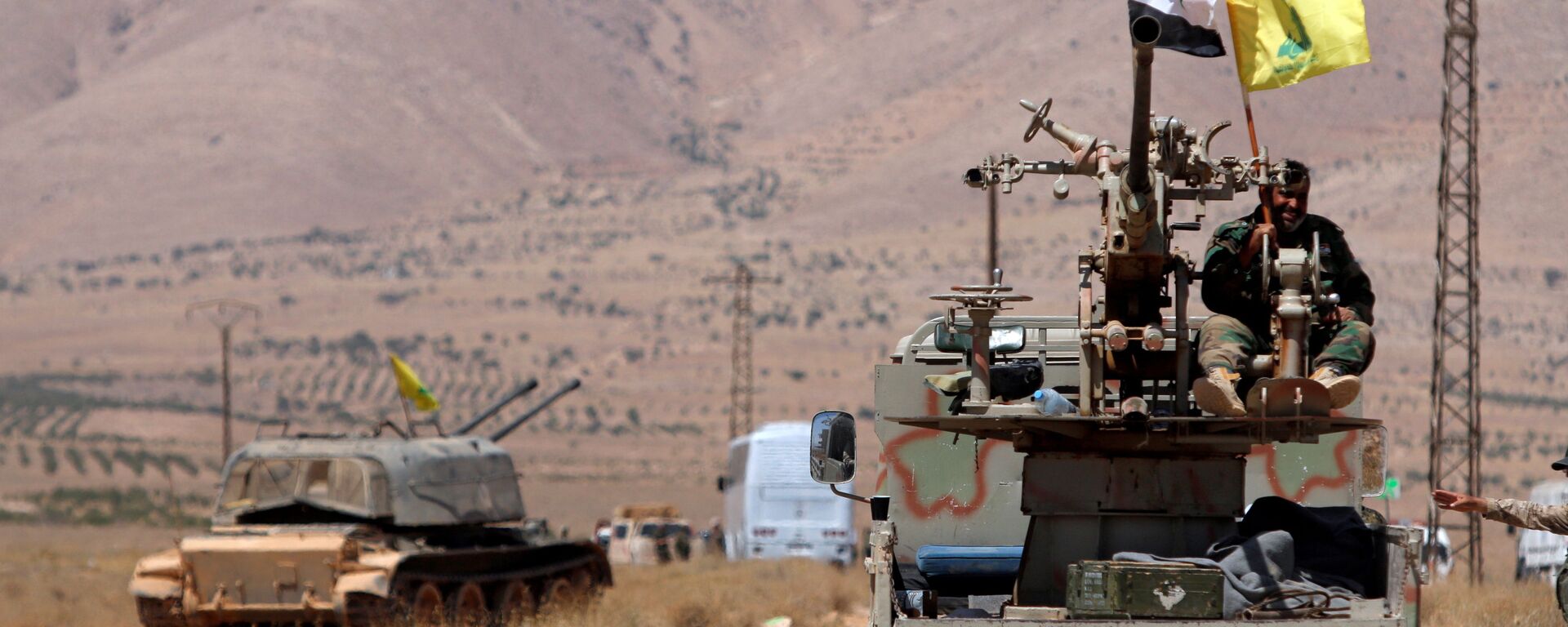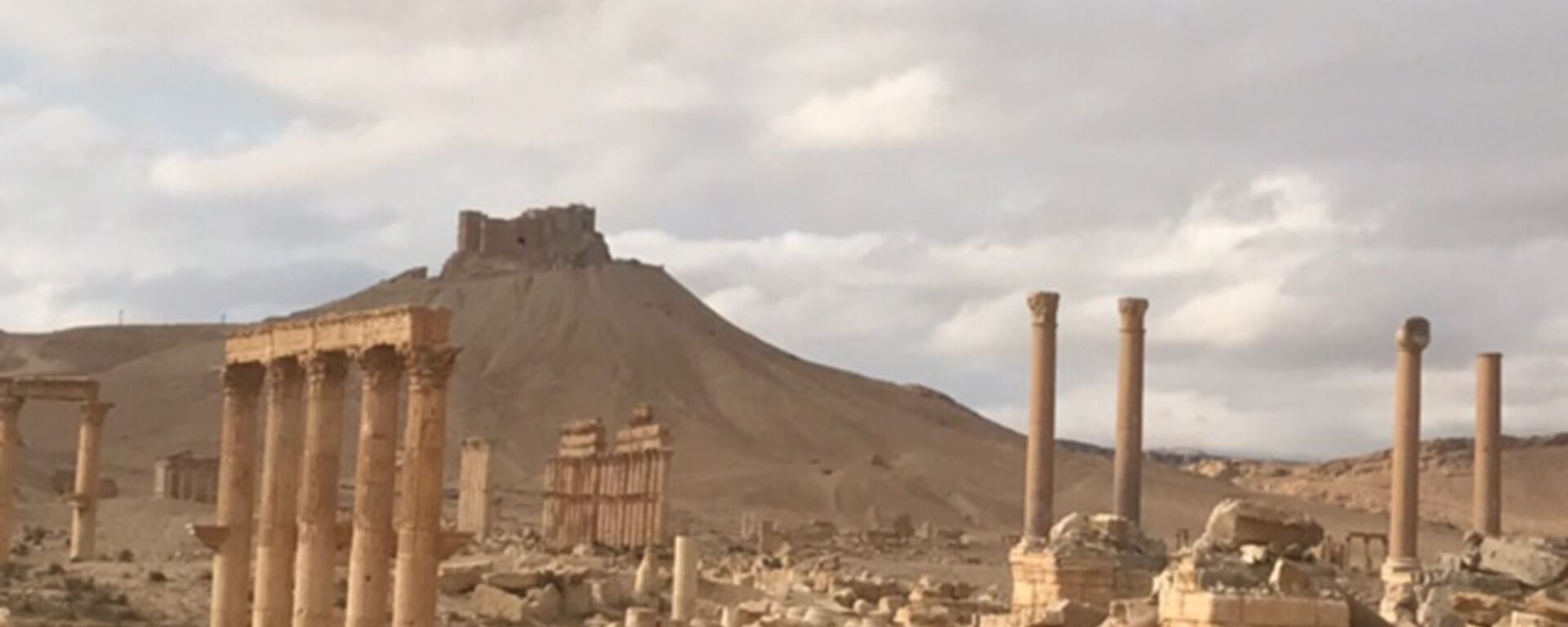https://sputnikglobe.com/20220714/russian-syrian-specialists-finish-first-phase-of-restoration-of-palmyras-1700-yo-arch-of-triumph-1097319039.html
Russian, Syrian Specialists Finish First Phase of Restoration of Palmyra’s 1,700 y/o Arch of Triumph
Russian, Syrian Specialists Finish First Phase of Restoration of Palmyra’s 1,700 y/o Arch of Triumph
Sputnik International
Situated in the heart of Syria, the ancient city of Palmyra’s UNESCO World Heritage Site architecture was devastated during Daesh (ISIS)* assaults. Syrian and... 14.07.2022, Sputnik International
2022-07-14T15:30+0000
2022-07-14T15:30+0000
2023-01-08T16:47+0000
palmyra
restoration
syria
https://cdn1.img.sputnikglobe.com/img/105127/93/1051279347_0:0:1920:1080_1920x0_80_0_0_1c5f67f222ee1345075e983a4a8fd44b.png
Specialists from Syria’s Directorate-General of Antiquities and Museums and the Institute of History and Material Culture of the Russian Academy of Sciences have completed field work for the first stage of restoration of Palmyra’s Arch of Triumph, the Syrian Arab News Agency has reported.Excavation work was also carried out around arch-bearing bases to ensure that there were no structural issues that could complicate rebuilding work.The Syrian Trust for Development, one of partners for the project alongside the Directorate-General, Syrian Ministry of Culture and the Russian Academy of Sciences, was said to have contributed over 160 million Syrian pounds (about $63,700 US) for the first stage of the restoration work, which began in May.From the Russian side, work will be implemented under the auspices of the Russian Geographical Society, with participation from the Ministry of Defense.Palmyra’s Arch of Triumph was destroyed by Daesh in May 2015, with the extremists dynamiting the arch and taking sledgehammers and other implements of destruction to other priceless sculptures and monuments in the city, including the ancient statue of the Lion of Allat, the Temple of Canaanite sky deity Baalshamin, and the Temple of Bel, built under Emperor Tiberius in 32 AD and consecrated to the ancient Mesopotamian god Baal. The Arch of Triumph dates back to the 3rd century and the reign of Roman Emperor Septimius Severus.Palmyra, built on an oasis in the Syrian desert between Damascus and the Euphrates River, is filled with riches of antiquity. Stone tools found at the site indicate that the area’s settlement goes back to at least 7500 BC, with layers of ruins showing continuous settlement since around 2500 BC. The city is mentioned in the historical record in about 2000 BC.During its occupation of Palmyra, Daesh instituted a reign of terror over the city, torturing and beheading Dr. Khaled al-Asaad, an 83-year-old Syrian archeologist who spent his life protecting Palmyra’s heritage, in 2015 as he worked to help evacuate the city’s museum.Syrian forces backed by Russian air power liberated Palmyra from Daesh in March 2016, with the terrorists returning in December of that year before being kicked out again in March 2017.The security situation around Palmyra remains uneasy. In April of this year, SANA reported that US instructors were training Daesh fighters held at a prison inside a military base in occupied Hasakah province, and transferring them for operations in Deir ez-Zor and near Palmyra to attack Syrian Army outposts and infrastructure.In March, after a Daesh attack on a bus carrying Syrian soldiers near Palmyra killed 13 troops and injured 18 others, the Syrian Foreign Ministry accused the Israeli Air Force of “coordinating” with the terrorists by attacking a Damascus suburb just hours later. The Russian military accused Israel of carrying a separate air strike near Palmyra under the cover of two civilian aircraft in October 2021.* A terrorist group outlawed in Russia and many other countries.
https://sputnikglobe.com/20211014/syrias-anti-daesh-allies-vow-to-respond-to-alleged-israeli-us-aggression-over-palmyra-1089924626.html
https://sputnikglobe.com/20220306/syrian-defense-ministry-says-13-syrian-soldiers-dead-18-injured-in-terrorist-attack-near-palmyra-1093638496.html
syria
Sputnik International
feedback@sputniknews.com
+74956456601
MIA „Rosiya Segodnya“
2022
News
en_EN
Sputnik International
feedback@sputniknews.com
+74956456601
MIA „Rosiya Segodnya“
Sputnik International
feedback@sputniknews.com
+74956456601
MIA „Rosiya Segodnya“
palmyra, restoration, syria
palmyra, restoration, syria
Russian, Syrian Specialists Finish First Phase of Restoration of Palmyra’s 1,700 y/o Arch of Triumph
15:30 GMT 14.07.2022 (Updated: 16:47 GMT 08.01.2023) Situated in the heart of Syria, the ancient city of Palmyra’s UNESCO World Heritage Site architecture was devastated during Daesh (ISIS)* assaults. Syrian and Russian archeologists, architects and other specialists have vowed to work together to restore the city’s priceless treasures.
Specialists from Syria’s Directorate-General of Antiquities and Museums and the Institute of History and Material Culture of the Russian Academy of Sciences have completed field work for the first stage of restoration of Palmyra’s Arch of Triumph, the Syrian Arab News Agency has
reported.
According to a statement by the Directorate-General seen by SANA, the extent of damage has been painstakingly studied by cutting-edge archeological instruments, part of which were provided by the Russian side. The arch stones of the ancient landmark have been thoroughly documented, sorted, and classified using three-dimensional technology to study their use for rebuilding the architectural marvel (a process known as anastylosis).
Excavation work was also carried out around arch-bearing bases to ensure that there were no structural issues that could complicate rebuilding work.
The Syrian Trust for Development, one of partners for the project alongside the Directorate-General, Syrian Ministry of Culture and the Russian Academy of Sciences, was said to have contributed over 160 million Syrian pounds (about $63,700 US) for the first stage of the restoration work, which began in May.
Russian Academy of Sciences’ Institute of Material Culture Natalya Solovieva said in March that the joint reconstruction effort would be carried out on the basis of a cooperation agreement, and indicated that consultations with international experts to discuss approaches to rebuilding the Ancient Roman monument will be held before restoration begins. According to Solovieva, the monument’s painstaking reconstruction will begin next spring, and take about three years to complete.
From the Russian side, work will be implemented under the auspices of the Russian Geographical Society, with participation from the Ministry of Defense.
Palmyra’s Arch of Triumph was destroyed by Daesh in May 2015, with the extremists dynamiting the arch and taking sledgehammers and other implements of destruction to other priceless sculptures and monuments in the city, including the ancient statue of the Lion of Allat, the Temple of Canaanite sky deity Baalshamin, and the Temple of Bel, built under Emperor Tiberius in 32 AD and consecrated to the ancient Mesopotamian god Baal. The Arch of Triumph dates back to the 3rd century and the reign of Roman Emperor Septimius Severus.
Palmyra, built on an oasis in the Syrian desert between Damascus and the Euphrates River, is filled with riches of antiquity. Stone tools found at the site indicate that the area’s settlement goes back to at least 7500 BC, with layers of ruins showing continuous settlement since around 2500 BC. The city is mentioned in the historical record in about 2000 BC.

14 October 2021, 13:55 GMT
During its occupation of Palmyra, Daesh instituted a reign of terror over the city, torturing and beheading Dr. Khaled al-Asaad, an 83-year-old Syrian archeologist who spent his life protecting Palmyra’s heritage, in 2015 as he worked to help evacuate the city’s museum.
Syrian forces backed by Russian air power liberated Palmyra from Daesh in March 2016, with the terrorists returning in December of that year before being kicked out again in March 2017.
The security situation around Palmyra remains uneasy. In April of this year, SANA
reported that US instructors were training Daesh fighters held at a prison inside a military base in occupied Hasakah province, and transferring them for operations in Deir ez-Zor and near Palmyra to attack Syrian Army outposts and infrastructure.
In March, after a Daesh attack on a bus carrying Syrian soldiers near Palmyra killed 13 troops and injured 18 others, the Syrian Foreign Ministry
accused the Israeli Air Force of “coordinating” with the terrorists by attacking a Damascus suburb just hours later. The Russian military
accused Israel of carrying a separate air strike near Palmyra under the cover of two civilian aircraft in October 2021.
* A terrorist group outlawed in Russia and many other countries.





